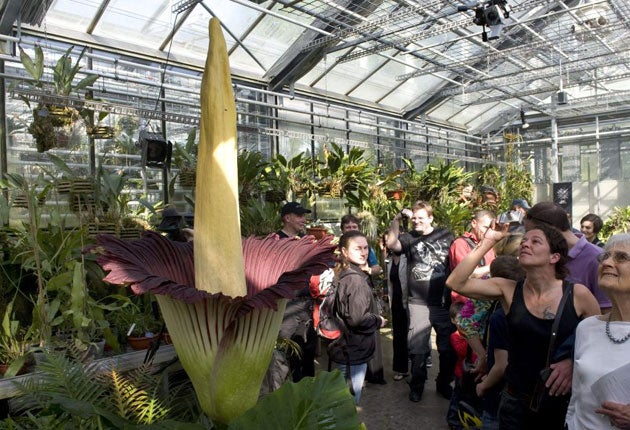What a carrion: plant lovers flock to see a rare and smelly flower

Your support helps us to tell the story
From reproductive rights to climate change to Big Tech, The Independent is on the ground when the story is developing. Whether it's investigating the financials of Elon Musk's pro-Trump PAC or producing our latest documentary, 'The A Word', which shines a light on the American women fighting for reproductive rights, we know how important it is to parse out the facts from the messaging.
At such a critical moment in US history, we need reporters on the ground. Your donation allows us to keep sending journalists to speak to both sides of the story.
The Independent is trusted by Americans across the entire political spectrum. And unlike many other quality news outlets, we choose not to lock Americans out of our reporting and analysis with paywalls. We believe quality journalism should be available to everyone, paid for by those who can afford it.
Your support makes all the difference.Thousands of plant lovers have flocked to the northern Swiss city of Basel to see a giant, foul-smelling flower bloom for the first time. The Basel Botanical Gardens expects 10,000 people to have filed past its Amorphophallus titanum, or corpse flower, standing in its full glory before the bloom wilts.
The plant is notorious for its incredibly pungent, suggestively shaped flower, which has been described as smelling like a combination of rotting flesh and burnt sugar. Its carrion smell attracts pollinating insects, but perhaps fortunately for humans, the flowering process is extremely rare, even in the wild.
There have been only 134 blooms from artificial cultivation recorded across the world; the plant in Basel had been growing for 17 years and is flowering for the first time.
As well as its distinctive odour and shape, Amorphophallus titanum is known for achieving remarkable size and rapid growth when ready to reproduce. The mature bloom can rise to more than 2.5m, making it one of the largest flowers in the world. It achieves this growth at surprising speed. The Basel Botanical Gardens has recorded an average growth of 6cm a day since its plant began blooming.
It is unlikely to be a sustained performance, however: the flower tends to wilt rapidly as soon as the pollination process is complete.
Basel's flower bloomed on Friday and was expected to wilt by last night. Due to its short life span, officials allowed 24-hour access to the plant, and set up a webcam to photograph it every 10 minutes.
Join our commenting forum
Join thought-provoking conversations, follow other Independent readers and see their replies
Comments